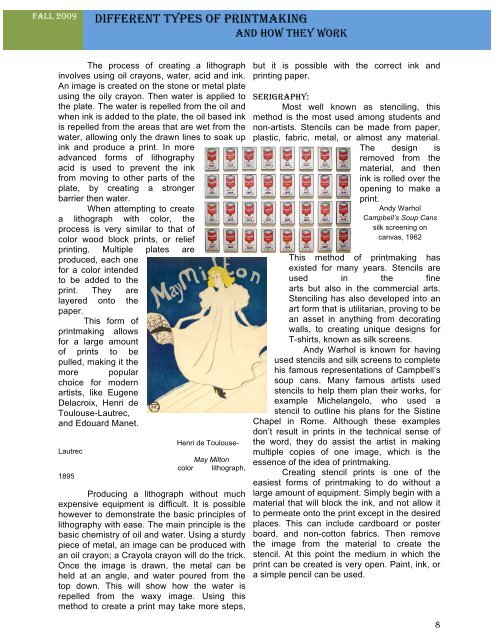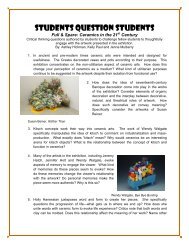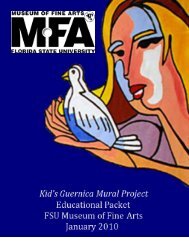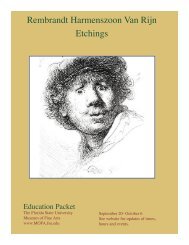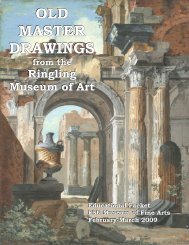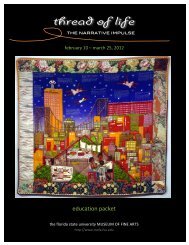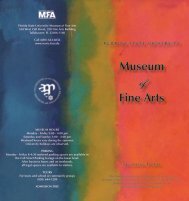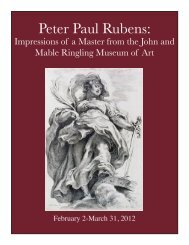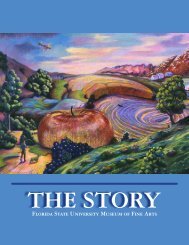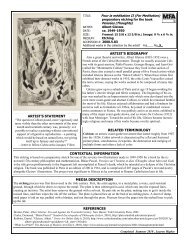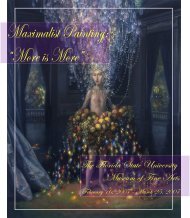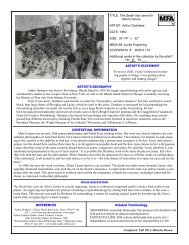Matrix: Contemporary Printmaking - Museum of Fine Arts - Florida ...
Matrix: Contemporary Printmaking - Museum of Fine Arts - Florida ...
Matrix: Contemporary Printmaking - Museum of Fine Arts - Florida ...
You also want an ePaper? Increase the reach of your titles
YUMPU automatically turns print PDFs into web optimized ePapers that Google loves.
Fall 2009<br />
Different Types <strong>of</strong> <strong>Printmaking</strong><br />
and How They Work<br />
The process <strong>of</strong> creating a lithograph<br />
involves using oil crayons, water, acid and ink.<br />
An image is created on the stone or metal plate<br />
using the oily crayon. Then water is applied to<br />
the plate. The water is repelled from the oil and<br />
when ink is added to the plate, the oil based ink<br />
is repelled from the areas that are wet from the<br />
water, allowing only the drawn lines to soak up<br />
ink and produce a print. In more<br />
advanced forms <strong>of</strong> lithography<br />
acid is used to prevent the ink<br />
from moving to other parts <strong>of</strong> the<br />
plate, by creating a stronger<br />
barrier then water.<br />
When attempting to create<br />
a lithograph with color, the<br />
process is very similar to that <strong>of</strong><br />
color wood block prints, or relief<br />
printing. Multiple plates are<br />
produced, each one<br />
for a color intended<br />
to be added to the<br />
print. They are<br />
layered onto the<br />
paper.<br />
This form <strong>of</strong><br />
printmaking allows<br />
for a large amount<br />
<strong>of</strong> prints to be<br />
pulled, making it the<br />
more popular<br />
choice for modern<br />
artists, like Eugene<br />
Delacroix, Henri de<br />
Toulouse-Lautrec,<br />
and Edouard Manet.<br />
Lautrec<br />
1895<br />
Henri de Toulouse-<br />
May Milton<br />
color lithograph,<br />
Producing a lithograph without much<br />
expensive equipment is difficult. It is possible<br />
however to demonstrate the basic principles <strong>of</strong><br />
lithography with ease. The main principle is the<br />
basic chemistry <strong>of</strong> oil and water. Using a sturdy<br />
piece <strong>of</strong> metal, an image can be produced with<br />
an oil crayon; a Crayola crayon will do the trick.<br />
Once the image is drawn, the metal can be<br />
held at an angle, and water poured from the<br />
top down. This will show how the water is<br />
repelled from the waxy image. Using this<br />
method to create a print may take more steps,<br />
but it is possible with the correct ink and<br />
printing paper.<br />
Serigraphy:<br />
Most well known as stenciling, this<br />
method is the most used among students and<br />
non-artists. Stencils can be made from paper,<br />
plastic, fabric, metal, or almost any material.<br />
The design is<br />
removed from the<br />
material, and then<br />
ink is rolled over the<br />
opening to make a<br />
print.<br />
Andy Warhol<br />
Campbell’s Soup Cans<br />
silk screening on<br />
canvas, 1962<br />
This method <strong>of</strong> printmaking has<br />
existed for many years. Stencils are<br />
used in the fine<br />
arts but also in the commercial arts.<br />
Stenciling has also developed into an<br />
art form that is utilitarian, proving to be<br />
an asset in anything from decorating<br />
walls, to creating unique designs for<br />
T-shirts, known as silk screens.<br />
Andy Warhol is known for having<br />
used stencils and silk screens to complete<br />
his famous representations <strong>of</strong> Campbell’s<br />
soup cans. Many famous artists used<br />
stencils to help them plan their works, for<br />
example Michelangelo, who used a<br />
stencil to outline his plans for the Sistine<br />
Chapel in Rome. Although these examples<br />
don’t result in prints in the technical sense <strong>of</strong><br />
the word, they do assist the artist in making<br />
multiple copies <strong>of</strong> one image, which is the<br />
essence <strong>of</strong> the idea <strong>of</strong> printmaking.<br />
Creating stencil prints is one <strong>of</strong> the<br />
easiest forms <strong>of</strong> printmaking to do without a<br />
large amount <strong>of</strong> equipment. Simply begin with a<br />
material that will block the ink, and not allow it<br />
to permeate onto the print except in the desired<br />
places. This can include cardboard or poster<br />
board, and non-cotton fabrics. Then remove<br />
the image from the material to create the<br />
stencil. At this point the medium in which the<br />
print can be created is very open. Paint, ink, or<br />
a simple pencil can be used.<br />
8


